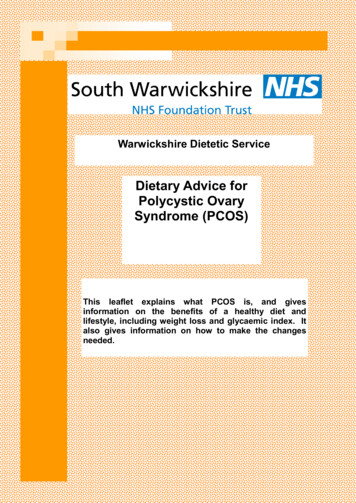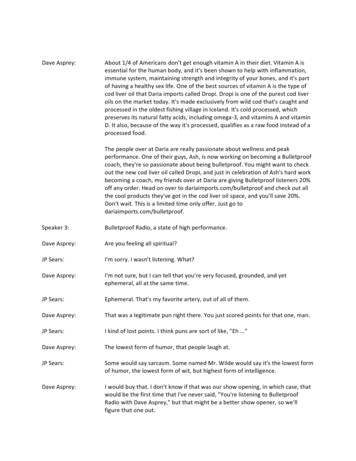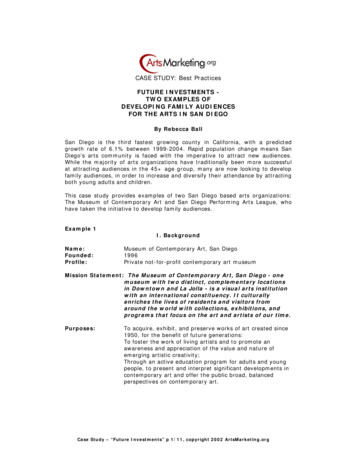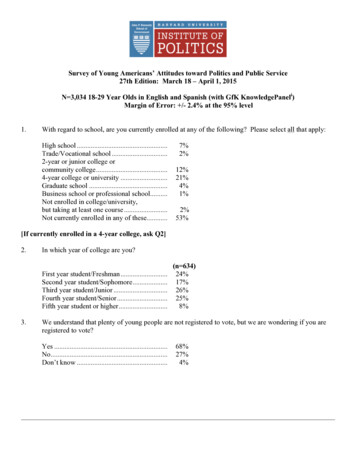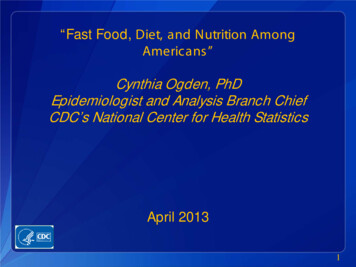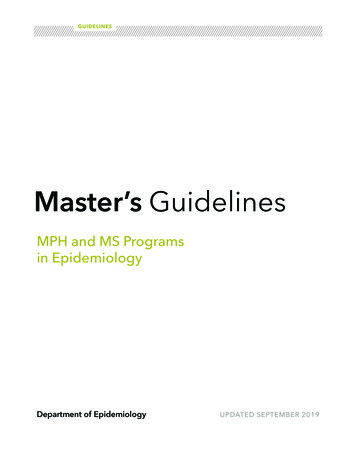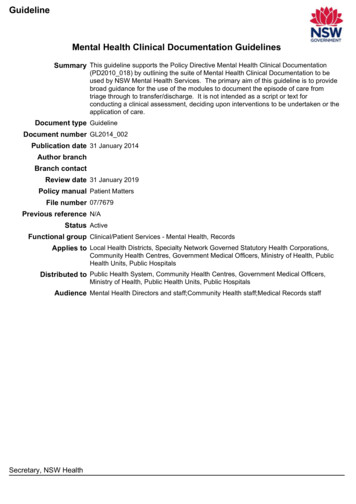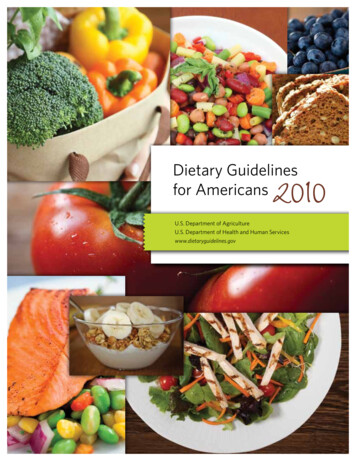
Transcription
Dietary Guidelinesfor AmericansU.S. Department of AgricultureU.S. Department of Health and Human Serviceswww.dietaryguidelines.gov
This publication may be viewed and downloaded from the Internet at www.dietaryguidelines.gov.Suggested citation: U.S. Department of Agriculture and U.S. Department of Health and HumanServices. Dietary Guidelines for Americans, 2010. 7th Edition, Washington, DC: U.S. GovernmentPrinting Office, December 2010.The U.S. Departments of Agriculture (USDA) and Health and Human Services (HHS) prohibitdiscrimination in all their programs and activities on the basis of race, color, national origin, age,disability and, where applicable, sex, marital status, familial status, parental status, religion,sexual orientation, genetic information, political beliefs, reprisal, or because all or part of anindividual’s income is derived from any public assistance program. (Not all prohibited bases applyto all programs.) Persons with disabilities who require alternative means for communicationof program information (Braille, large print, audiotape, etc.) should contact USDA’s TARGETCenter at (202) 720-2600 (voice and TDD). To file a complaint of discrimination, write to USDA,Director, Office of Civil Rights, 1400 Independence Avenue, SW, Washington, DC 20250-9410,or call (800) 795-3272 (voice) or (202) 720-6382 (TDD). USDA and HHS are equal opportunityproviders and employers.December 2010
MESSAGE FROM THE SECRETARIESWe are pleased to present the Dietary Guidelines for Americans, 2010. Based on the most recentscientific evidence review, this document provides information and advice for choosing ahealthy eating pattern—namely, one that focuses on nutrient-dense foods and beverages, andthat contributes to achieving and maintaining a healthy weight. Such a healthy eating patternalso embodies food safety principles to avoid foodborne illness.The 2010 Dietary Guidelines are intended to be used in developing educational materials andaiding policymakers in designing and carrying out nutrition-related programs, including Federalnutrition assistance and education programs. The Dietary Guidelines also serve as the basisfor nutrition messages and consumer materials developed by nutrition educators and healthprofessionals for the general public and specific audiences, such as children.This document is based on the recommendations put forward by the 2010 Dietary GuidelinesAdvisory Committee. The Committee was composed of scientific experts who reviewed andanalyzed the most current information on diet and health and incorporated it into a scientific,evidence-based report. We want to thank them and the other public and private professionalswho assisted in developing this document for their hard work and dedication.Our knowledge about nutrition, the food and physical activity environment, and healthcontinues to grow, reflecting an evolving body of evidence. It is clear that healthy eatingpatterns and regular physical activity are essential for normal growth and development and forreducing risk of chronic disease. The goal of the Dietary Guidelines is to put this knowledgeto work by facilitating and promoting healthy eating and physical activity choices, with theultimate purpose of improving the health of all Americans ages 2 years and older.We are releasing the seventh edition of the Dietary Guidelines at a time of rising concern aboutthe health of the American population. Americans are experiencing an epidemic of overweightand obesity. Poor diet and physical inactivity also are linked to major causes of illness anddeath. To correct these problems, many Americans must make significant changes in theireating habits and lifestyles. This document recognizes that all sectors of society, includingindividuals and families, educators and health professionals, communities, organizations,businesses, and policymakers, contribute to the food and physical activity environments inwhich people live. We all have a role to play in reshaping our environment so that healthychoices are easy and accessible for all.Today, more than ever, consumers need sound advice to make informed food and activitydecisions. The 2010 Dietary Guidelines will help Americans choose a nutritious diet withintheir calorie needs. We believe that following the recommendations in the Dietary Guidelineswill assist many Americans to live longer, healthier, and more active lives.Thomas J. VilsackSecretary of AgricultureKathleen SebeliusSecretary of Health and Human ServicesDIETARY GUIDELINES FOR AMERICANS, 2010i
ACKNOWLEDGMENTSThe U.S. Department of Agriculture and the U.S. Department of Health and HumanServices acknowledge the work of the 2010 Dietary Guidelines Advisory Committee whoserecommendations formed the basis for this edition of the Dietary Guidelines for Americans.Dietary Guidelines Advisory Committee MembersLinda Van Horn, PhD, RD, LD; Naomi K. Fukagawa, MD, PhD; Cheryl Achterberg, PhD;Lawrence J. Appel, MD, MPH; Roger A. Clemens, DrPH; Miriam E. Nelson, PhD; Sharon(Shelly) M. Nickols-Richardson, PhD, RD; Thomas A. Pearson, MD, PhD, MPH; Rafael PérezEscamilla, PhD; F. Xavier Pi-Sunyer, MD, MPH; Eric B. Rimm, ScD; Joanne L. Slavin, PhD, RD;Christine L. Williams, MD, MPH.The Departments also acknowledge the work of the departmental scientists, staff, and policyofficials responsible for the production of this document.Policy OfficialsUSDA: Kevin W. Concannon; Rajen S. Anand, DVM, PhD; Robert C. Post, PhD, MEd, MSc.HHS: Howard K. Koh, MD, MPH; Penelope Slade-Sawyer, PT, MSW, RADM, USPHS.Policy Document Writing StaffCarole A. Davis, MS; Kathryn Y. McMurry, MS; Patricia Britten, PhD, MS; Eve V. Essery, PhD;Kellie M. O’Connell, PhD, RD; Paula R. Trumbo, PhD; Rachel R. Hayes, MPH, RD; Colette I.Rihane, MS, RD; Julie E. Obbagy, PhD, RD; Patricia M. Guenther, PhD, RD; Jan Barrett Adams,MS, MBA, RD; Shelley Maniscalco, MPH, RD; Donna Johnson-Bailey, MPH, RD; Anne BrownRodgers, Scientific Writer/Editor.Policy Document Reviewers/Technical AssistanceJackie Haven, MS, RD; Joanne Spahn, MS, RD; Shanthy Bowman, PhD; Holly H. McPeak, MS;Shirley Blakely, PhD, RD; Kristin L. Koegel, MBA, RD; Kevin Kuczynski, MS, RD; Kristina Davis,MS, MPH; Jane Fleming; David Herring, MS; Linda Cleveland, MS, RD.The Departments would like to acknowledge the important role of those who provided inputand public comments throughout this process. Finally, the Departments acknowledge thecontributions of numerous other internal departmental and external scientists and staff whocontributed to the production of this document, including the members of the IndependentScientific Review Panel, who peer reviewed the recommendations of the document to ensurethey were based on the preponderance of the scientific evidence.iiDIETARY GUIDELINES FOR AMERICANS, 2010
DIETARY GUIDELINES FOR AMERICANS, 2010iii
CONTENTSExecutive Summary. viiiChapter 1 Introduction.1Developing the Dietary Guidelines for Americans, 2010 .2A Roadmap to the Dietary Guidelines for Americans, 2010 .4Sources of Information. 5Importance of the Dietary Guidelines for Health Promotion and Disease Prevention .5Uses of the Dietary Guidelines for Americans, 2010.6Development of Educational Materials and Communications. 6Development of Nutrition-Related Programs. 6Development of Authoritative Statements. 7Chapter 2 Balancing Calories to Manage Weight. 8Key Recommendations . 9An Epidemic of Overweight and Obesity. 9Contributing to the Epidemic: An Obesogenic Environment . 10Current Dietary Intake . 11Calorie Balance: Food and Beverage Intake .13Understanding Calorie Needs .13Carbohydrate, Protein, Fat, and Alcohol . 14Does Macronutrient Proportion Make a Difference for Body Weight?Individual Foods and Beverages and Body Weight .15Placing Individual Food Choices Into an Overall Eating Pattern .16Calorie Balance: Physical Activity .17Principles for Promoting Calorie Balance and Weight Management .17Improving Public Health Through Diet and Physical Activity .19Chapter 3 Foods and Food Components to Reduce .20Key Recommendations .21Supporting the Recommendations .21Sodium.21Fats .24Saturated Fatty AcidsTrans Fatty AcidsCholesterolCalories From Solid Fats and Added Sugars .27Solid FatsAdded SugarsWhy Solid Fats and Added Sugars Are a Particular ConcernRefined Grains .29Alcohol .30Chapter Summary .32ivDIETARY GUIDELINES FOR AMERICANS, 2010
Chapter 4 Foods and Nutrients to Increase. 33Key Recommendations .34Recommendations for Specific Population Groups .34Supporting the Recommendations .35Vegetables and Fruits .35Grains.36Whole GrainsMilk and Milk Products .38Protein Foods .38SeafoodOils .39Nutrients of Concern . 40PotassiumDietary FiberCalciumVitamin DAdditional Nutrients of Concern for Specific GroupsChapter Summary .42Chapter 5 Building Healthy Eating Patterns.43Key Recommendations .43Research Informs Us about Healthy Eating Patterns . 44Research on Dietary Approaches to Stop Hypertension (DASH) . 44Research on Mediterranean-Style Eating Patterns . 44Research on Vegetarian Eating Patterns.45Common Elements of the Healthy Eating Patterns Examined.45Principles for Achieving a Healthy Eating Pattern . 46Focus on Nutrient-Dense Foods . 46Remember that Beverages Count.47Follow Food Safety Principles . 48Consider the Role of Supplements and Fortified Foods.49Putting the Principles for a Healthy Eating Pattern Into Action . 50USDA Food Patterns . 50Vegetarian Adaptations of the USDA Food Patterns .52DASH Eating Plan .53Chapter Summary .53Chapter 6 Helping Americans Make Healthy Choices . 55A Call to Action .57Ensure that All Americans Have Access to Nutritious Foods andOpportunities for Physical Activity .57Facilitate Individual Behavior Change Through Environmental Strategies .58Set the Stage for Lifelong Healthy Eating, Physical Activity,and Weight Management Behaviors.58Chapter Summary .59Resource List .59DIETARY GUIDELINES FOR AMERICANS, 2010v
AppendicesAppendix 1 Guidance for Specific Population Groups.61Appendix 2 Key Consumer Behaviors and Potential Strategies forProfessionals to Use in Implementing the 2010 Dietary Guidelines.62Appendix 3 Food Safety Principles and Guidance for Consumers .69Appendix 4 Using the Food Label to Track Calories, Nutrients, and Ingredients.73Appendix 5 Nutritional Goals for Age-Gender Groups, Based onDietary Reference Intakes and Dietary Guidelines Recommendations.76Appendix 6 Estimated Calorie Needs per Day by Age, Gender, andPhysical Activity Level (Detailed) .78Appendix 7 USDA Food Patterns.79Appendix 8 Lacto-Ovo Vegetarian Adaptation of the USDA Food Patterns.81Appendix 9 Vegan Adaptation of the USDA Food Patterns .82Appendix 10 The DASH Eating Plan at Various Calorie Levels.83Appendix 11 Estimated EPA and DHA and Mercury Content in 4 Ouncesof Selected Seafood Varieties.85Appendix 12 Selected Food Sources Ranked by Amounts of Potassiumand Calories per Standard Food Portion.87Appendix 13 Selected Food Sources Ranked by Amounts of DietaryFiber and Calories per Standard Food Portion .88Appendix 14 Selected Food Sources Ranked by Amounts of Calciumand Calories per Standard Food Portion.89Appendix 15 Selected Food Sources Ranked by Amounts of Vitamin Dand Calories per Standard Food Portion. 90Appendix 16 Glossary of Terms .91viDIETARY GUIDELINES FOR AMERICANS, 2010
List of TablesTable 2-1 Obesity in America Then and Now . 10Table 2-2 Top 25 Sources of Calories Among Americans Ages2 Years and Older, NHANES 2005–2006.12Table 2-3 Estimated Calorie Needs per Day by Age, Gender,and Physical Activity Level. 14Table 2-4 Recommended Macronutrient Proportions by Age.15Table 2-5 2008 Physical Activity Guidelines .18Table 5-1 Eating Pattern Comparison: Usual U.S. Intake, Mediterranean,DASH, and USDA Food Patterns, Average Daily Intake at or Adjusted to a2,000 Calorie Level.51Table 5-2 USDA Food Patterns—Food Groups and Subgroups .52Table 5-3 Average Daily Amounts in the Protein Foods Group in the USDA FoodPattern at the 2,000 Calorie Level and its Vegetarian Adaptations .53List of FiguresFigure 3-1 Estimated Mean Daily Sodium Intake, by Age–GenderGroup, NHANES 2005–2006 .22Figure 3-2 Sources of Sodium in the Diets of the U.S. PopulationAges 2 Years and Older, NHANES 2005–2006.22Figure 3-3 Fatty Acid Profiles of Common Fats and Oils.25Figure 3-4 Sources of Saturated Fat in the Diets of the U.S. PopulationAges 2 Years and Older, NHANES 2005–2006.26Figure 3-5 Sources of Solid Fats in the Diets of the U.S. PopulationAges 2 Years and Older, NHANES 2003–2004.28Figure 3-6 Sources of Added Sugars in the Diets of the U.S.Population Ages 2 Years and Older, NHANES 2005–2006.29Figure 3-7 Sources of Refined Grains in the Diets of the U.S.Population Ages 2 Years and Older, NHANES 2003–2004.30Figure 4-1 Three Ways to Make at Least Half of Total Grains Whole Grains.37Figure 5-1 How Do Typical American Diets Compare to RecommendedIntake Levels or Limits?. 46Figure 5-2 Examples of the Calories in Food Choices that are not in NutrientDense Forms and the Calories in Nutrient-Dense Forms of these Foods.47Figure 6-1 A Social-Ecological Framework for Nutrition andPhysical Activity Decisions.56DIETARY GUIDELINES FOR AMERICANS, 2010vii
Executive SummaryEating and physical activity patterns that are focusedon consuming fewer calories, making informed foodchoices, and being physically active can help peopleattain and maintain a healthy weight, reduce theirrisk of chronic disease, and promote overall health.The Dietary Guidelines for Americans, 2010 exemplifies these strategies through recommendations thataccommodate the food preferences, cultural traditions, and customs of the many and diverse groupswho live in the United States.By law (Public Law 101-445, Title III, 7 U.S.C. 5301et seq.), Dietary Guidelines for Americans is reviewed,updated if necessary, and published every 5 years.The U.S. Department of Agriculture (USDA) andthe U.S. Department of Health and Human Services(HHS) jointly create each edition. Dietary Guidelinesfor Americans, 2010 is based on the Report of theDietary Guidelines Advisory Committee on the DietaryGuidelines for Americans, 2010 and consideration ofFederal agency and public comments.Dietary Guidelines recommendations traditionallyhave been intended for healthy Americans ages2 years and older. However, Dietary Guidelines forAmericans, 2010 is being released at a time of risingconcern about the health of the American population. Poor diet and physical inactivity are the mostimportant factors contributing to an epidemic ofoverweight and obesity affecting men, women, andchildren in all segments of our society. Even in theabsence of overweight, poor diet and physical inactivity are associated with major causes of morbidityand mortality in the United States. Therefore, theDietary Guidelines for Americans, 2010 is intended forAmericans ages 2 years and older, including those atincreased risk of chronic disease.Dietary Guidelines for Americans, 2010 also recognizesthat in recent years nearly 15 percent of Americanhouseholds have been unable to acquire adequatefood to meet their needs.1 This dietary guidancecan help them maximize the nutritional content of1. Nord M, Coleman-Jensen A, Andrews M, Carlson S. Household food security in the United States, 2009. Washington (DC): U.S. Department ofAgriculture, Economic Research Service. 2010 Nov. Economic Research Report No. ERR-108. Available from ETARY GUIDELINES FOR AMERICANS, 2010
their meals. Many other Americans consume lessthan optimal intake of certain nutrients even thoughthey have adequate resources for a healthy diet. Thisdietary guidance and nutrition information can helpthem choose a healthy, nutritionally adequate diet.The intent of the Dietary Guidelines is to summarizeand synthesize knowledge about individual nutrients and food components into an interrelated setof recommendations for healthy eating that can beadopted by the public. Taken together, the DietaryGuidelines recommendations encompass two overarching concepts: Maintain calorie balance over time to achieve andsustain a healthy weight. People who are mostsuccessful at achieving and maintaining a healthyweight do so through continued attention to consuming only enough calories from foods and beverages to meet their needs and by being physicallyactive. To curb the obesity epidemic and improvetheir health, many Americans must decrease thecalories they consume and increase the caloriesthey expend through physical activity. Focus on consuming nutrient-dense foods andbeverages. Americans currently consume toomuch sodium and too many calories from solid fats,added sugars, and refined grains.2 These replacenutrient-dense foods and beverages and makeit difficult for people to achieve recommendednutrient intake while controlling calorie and sodiumintake. A healthy eating pattern limits intake ofsodium, solid fats, added sugars, and refined grainsand emphasizes nutrient-dense foods and beverages—vegetables, fruits, whole grains, fat-freeor low-fat milk and milk products,3 seafood, leanmeats and poultry, eggs, beans and peas, and nutsand seeds.A basic premise of the Dietary Guidelines is thatnutrient needs should be met primarily throughconsuming foods. In certain cases, fortified foods anddietary supplements may be useful in providing oneor more nutrients that otherwise might be consumedin less than recommended amounts. Two eatingpatterns that embody the Dietary Guidelines are theUSDA Food Patterns and their vegetarian adaptations and the DASH (Dietary Approaches to StopHypertension) Eating Plan.A healthy eating pattern needs not only to promotehealth and help to decrease the risk of chronicdiseases, but it also should prevent foodborne illness.Four basic food safety principles (Clean, Separate,Cook, and Chill) work together to reduce the risk offoodborne illnesses. In addition, some foods (such asmilks, cheeses, and juices that have not been pasteurized, and undercooked animal foods) pose highrisk for foodborne illness and should be avoided.The information in the Dietary Guidelines for Americansis used in developing educational materials andaiding policymakers in designing and carrying outnutrition-related programs, including Federal food,nutrition education, and information programs. Inaddition, the Dietary Guidelines for Americans has thepotential to offer authoritative statements as providedfor in the Food and Drug Administration ModernizationAct (FDAMA).The following are the Dietary Guidelines for Americans,2010 Key Recommendations, listed by the chapterin which they are discussed in detail. These KeyRecommendations are the most important in termsof their implications for improving public health.4 Toget the full benefit, individuals should carry out theDietary Guidelines recommendations in their entiretyas part of an overall healthy eating pattern.2. Added sugars: Caloric sweeteners that are added to foods during processing, preparation, or consumed separately. Solid fats: Fats with a high content ofsaturated and/or trans fatty acids, which are usually solid at room temperature. Refined grains: Grains and grain products missing the bran, germ, and/orendosperm; any grain product that is not a whole grain.3. Milk and milk products also can be referred to as dairy products.4. Information on the type and strength of evidence supporting the Dietary Guidelines recommendations can be found at http://www.nutritionevidencelibrary.gov.DIETARY GUIDELINES FOR AMERICANS, 2010ix
BALANCING CALORIES TOMANAGE WEIGHT KeyRecommendations FOODS AND FOODCOMPONENTS TO REDUCE 5. See Chapter 3, Foods and Food Components to Reduce, for additional recommendations on alcohol consumption and specific population groups. Thereare many circumstances when people should not drink alcohol.xDIETARY GUIDELINES FOR AMERICANS, 2010
FOODS AND NUTRIENTS TO INCREASEWomen capable of becoming pregnant7 Women who are pregnant or breastfeeding7 Individuals ages 50 years and older BUILDING HEALTHY EATING PATTERNS 6. Fortified soy beverages have been marketed as “soymilk,” a product name consumers could see in supermarkets and consumer materials. However,FDA’s regulations do not contain provisions for the use of the term soymilk. Therefore, in this document, the term “fortified soy beverage” includes productsthat may be marketed as soymilk.7. Includes adolescent girls.8. “Folic acid” is the synthetic form of the nutrient; whereas, “folate” is the form found naturally in foods.DIETARY GUIDELINES FOR AMERICANS, 2010xi
Chapter 1IntroductionIn 1980, the U.S. Department of Agriculture (USDA)and the U.S. Department of Health and HumanServices (HHS) released the first edition of Nutritionand Your Health: Dietary Guidelines for Americans. TheseDietary Guidelines were different from previous dietaryguidance in that they reflected emerging scientificevidence about diet and health and expanded thetraditional focus on nutrient adequacy to also addressthe impact of diet on chronic disease.Subsequent editions of the Dietary Guidelines forAmericans have been remarkably consistent intheir recommendations about the components of ahealth-promoting diet, but they also have changedin some significant ways to reflect an evolving bodyof evidence about nutrition, the food and physicalactivity environment, and health. The ultimate goalof the Dietary Guidelines for Americans is to improvethe health of our Nation’s current and future generations by facilitating and promoting healthy eatingand physical activity choices so that these behaviorsbecome the norm among all individuals.The recommendations contained in the DietaryGuidelines for Americans traditionally have beenintended for healthy Americans ages 2 years andolder. However, Dietary Guidelines for Americans, 2010is being released at a time of rising concern aboutthe health of the American population. Its recommendations accommodate the reality that a largepercentage of Americans are overweight or obeseand/or at risk of various chronic diseases. Therefore,the Dietary Guidelines for Americans, 2010 is intendedfor Americans ages 2 years and older, includingthose who are at increased risk of chronic disease.Poor diet and physical inactivity are the most important factors contributing to an epidemic of overweightand obesity in this country. The most recent dataindicate that 72 percent of men and 64 percent ofwomen are overweight or obese, with about one-thirdof adults being obese.9 Even in the absence of overweight, poor diet and physical inactivity are associated with major
DIETARY GUIDELINES FOR AMERICANS, 2010 MESSAGE FROM THE SECRETARIES We are pleased to present the Dietary Guidelines for Americans, 2010. Based on the most recent scientific evidence review, thi

